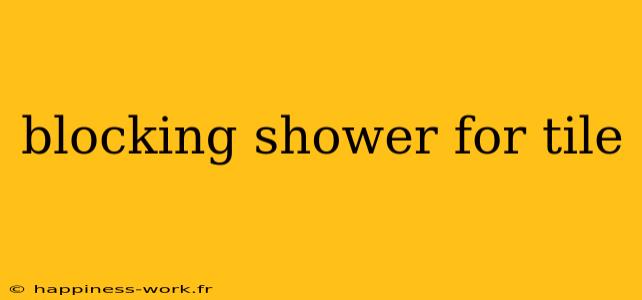When it comes to renovating your bathroom, one of the essential steps is preparing your shower area for tiling. Blocking a shower for tile installation is crucial to ensuring a moisture-resistant, long-lasting finish. In this article, we’ll explore how to effectively block a shower for tile, answer common questions, and provide additional tips for a successful installation.
What Does "Blocking a Shower for Tile" Mean?
Blocking a shower for tile involves creating a supportive framework that helps secure the tile while providing the necessary protection against water damage. This includes using backing boards, waterproof membranes, and sometimes adding blocking in the wall framing.
Why is Blocking Important?
- Water Resistance: Proper blocking helps prevent moisture from seeping into wall cavities.
- Structural Support: It provides a solid base for your tiles, reducing the risk of cracking or shifting.
- Aesthetic Finish: Proper blocking can enhance the overall appearance and longevity of your tiled shower.
Step-by-Step Guide to Blocking a Shower for Tile
Step 1: Gather Materials and Tools
Before you start, gather the following materials and tools:
-
Materials:
- Cement board or backer board
- Waterproof membrane
- Wood blocks (for blocking)
- Thin-set mortar
- Tile
-
Tools:
- Measuring tape
- Utility knife
- Drill and screws
- Trowel
- Level
Step 2: Prepare the Area
- Remove Old Fixtures: If you’re renovating, take out existing tiles, fixtures, and any old backer board.
- Inspect the Wall Framing: Check for any damage and ensure the framing is sturdy and level.
Step 3: Install Blocking
- Measure and Cut Wood Blocks: Measure the height of the shower walls and cut blocks to fit between the wall studs, typically at 16-inch intervals.
- Attach the Blocks: Securely fasten the blocks horizontally between the studs using screws. These will provide extra support for the edges of the backer board.
Step 4: Install Cement Board
- Cut the Cement Board: Measure and cut cement board to fit the shower walls.
- Attach the Cement Board: Using screws, secure the cement board to the wall studs and blocking, making sure to leave a small gap at the bottom.
Step 5: Apply Waterproof Membrane
- Select the Right Membrane: Choose a waterproof membrane suitable for showers, such as a liquid-applied or sheet membrane.
- Apply the Membrane: Follow the manufacturer’s instructions to apply the waterproof membrane over the cement board, ensuring all seams and edges are sealed.
Step 6: Tile Installation
- Plan Your Tile Layout: Dry fit your tiles to see how they will look and make adjustments as necessary.
- Use Thin-set Mortar: Spread thin-set mortar on the cement board using a trowel, then press your tiles into the mortar, ensuring they are level and evenly spaced.
- Grout and Seal: Once the tiles are set, apply grout between the tiles, and finish by sealing the edges and corners to ensure a watertight seal.
Common Questions About Blocking a Shower for Tile
How do I ensure my shower is watertight?
According to WikiHow, "to make sure your shower is watertight, apply a waterproof membrane and seal all joints properly." Additionally, use silicone caulk on edges and transitions.
What type of backer board should I use?
The most commonly recommended backer boards for showers are cement board or fiber-cement board. They are resistant to moisture and provide a sturdy base for tile.
Is it necessary to use a waterproof membrane?
Yes, it is essential to use a waterproof membrane to prevent water from seeping behind the tiles and causing mold or structural damage.
Additional Tips for Successful Tile Installation
- Consider Heated Flooring: For added comfort, consider installing heated flooring under the tiles for a luxurious feel.
- Use a Level: Always ensure that your tiles are level during installation to avoid issues later on.
- Choose High-Quality Materials: Investing in high-quality tile, mortar, and membranes can enhance the longevity and performance of your shower.
Conclusion
Blocking a shower for tile installation might seem like a daunting task, but with the right materials, tools, and techniques, you can create a beautiful, functional shower that stands the test of time. By following this guide and keeping in mind the additional tips, you'll ensure your shower renovation is a success.
Sources
- WikiHow: How to Tile a Shower
With proper planning and execution, transforming your shower space can enhance not just the beauty but the value of your home. Happy tiling!
